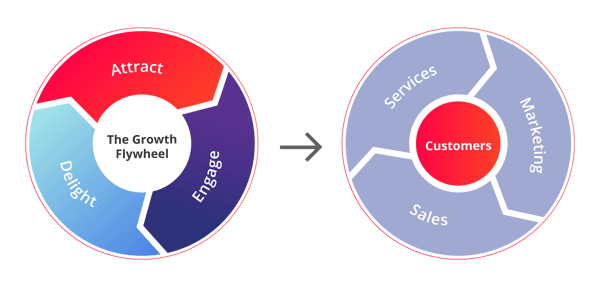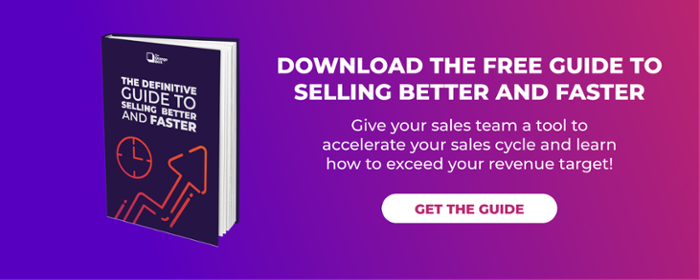Lead Generation
A Tale of Two Steps: Lead Generation and Customer Acquisition

Lean Fernandez
Lean Fernandez | Feb 07, 2019 | 5 MIN READ
Feb 07, 2019 5 MIN READ

Lead generation and customer acquisition are not the same.
SAY WHAT?! There’s actually a difference between the two? I mean, they’re both about getting people interested in you… right?
Wrong.
Ladies and gentlemen of the interwebs, although both processes happen within the same sales flywheel, they are located in different steps or phases. In a sales flywheel, there are three major steps: lead generation, customer acquisition, and conversion.
<<Download our Free Guide to accelerate your sales cycle and learn how to exceed your revenue target!>>
The Difference Between Lead Generation and Customer Acquisition
By definition, lead generation is “the action or process of identifying and cultivating potential customers for a business's products or services.” Basically, what lead generation does for your business is it gets people in the door, without any guarantee of a purchase.
In short, people go inside your store because the sign on the window caught their attention—but they aren’t particularly keen on giving you their money just yet.
In our previous post, we talked about how you can set up a solid lead generation strategy this year, one that will help you get those eyeballs and conversions too!
Customer acquisition, on the other hand, simply means “gaining new customers.” And what makes one a customer? It’s when a person has actually purchased a product or service from you or your business.
This means that they stepped into your shop, looked around, found something they wanted, and gave you their money.
Lead Generation and Customer Acquisition Combined
Lead generation and customer acquisition should go hand-in-hand. After all, what use is a great product sitting on the shelves of your shop if no one is buying them because nobody knows it even exists? Also… what a waste of marketing effort if you waste your leads by stopping as soon as they give up their contact info over to you.
We’ve said this once, and we’re saying it again: engage your leads so they are convinced to purchase from you.
To summarize, the first two steps in the sales flywheel - or the “attract” phase - can collectively be called the acquisition phase.

Calculating Customer Acquisition Cost
In business, customer acquisition cost (CAC) is an important measure of how much value a customer brings. By definition, it is “the cost associated with bringing a new customer or client to your business, such as marketing costs, events, and advertising.” There are two ways CAC is calculated: either in reference to a specific campaign or by a date range or period.
Why do you, as a business, need to figure out your CAC?
Well… customer acquisition costs give businesses a clear understanding of the real value of your marketing efforts. Remember, you’re running a business, not a charity - so it’s a must that you are able to identify how much time, energy, and money is spent on one aspect of the biz and how much ROI you’re getting.
Customer Acquisition Cost Formula
The CAC formula is pretty straightforward: all you have to do is take the total cost of your marketing efforts and divide it by the number of customer acquired for that specific campaign.
So:
MC/CA = CAC
where MC = marketing costs; CA = customers acquired; CAC = customer acquisition cost
For a more accurate CAC, you must include all other costs related to your marketing campaigns, such as:
- Wages (for sales and marketing staff)
- Software used
- Outsourced services
- Overhead costs for marketing and sales
You may factor these in and add each to your marketing costs before dividing by the total number of customers acquired.
The simpler, straightforward formula can be applied to a single campaign while the second, more complex formula can be applied to campaigns within a specific time window (such as one fiscal year or one quarter).
For example, you spent a total of $1,000 in ads and promotion for a single campaign in Q4 of 2018, and 10 people became customers.
Your CAC, therefore, is $100. Depending on the status of your business, you can then decide whether this is a high or low CAC.
How to Minimize Customer Acquisition Costs
The lower the CAC, the better — that’s a fact known to all marketers. With that said, you can always figure out ways or come up with hacks to lower down your CAC.
1. Improve website conversions. The way to better conversions is by having clear call-to-action message on your site. Ensure that your audience knows exactly what they will get and how they can get it by making it very easy for them.
Optimize your website for both desktop and mobile to lower bounce rates and tweak your landing pages to ensure that the winning version (from an A/B split test) is running.
2. Tap into your evangelists. You know those people who have already tried your product and are raving about it? Yes, those people!
Use their satisfaction to your advantage by a) encouraging them to refer you to their friends and family and b) releasing a new product which you feel will be beneficial to them.
3. Revisit your customer acquisition strategy and adjust as needed. Take a look at the current CA strategy you’re going with - what areas can you cut back on? What costs can you lower down? Research new channels where you can promote and run your strategy on and ditch the ones that are costing you more and not giving you the results you need.
Conclusion
In the end, what matters most is the quality of your product or service. As time goes, your product will speak for itself and before long, customers will come flocking toward you.
In the meantime, though, while you’re still working on making that mark, read up on other ways to improve your lead generation and customer acquisition strategies. Before long, you will have mastered the art of sales and marketing.
TABLE OF CONTENTS
Stay Updated with Our
Latest Posts
Subscribe now to receive the freshest content, insights, and updates directly in your inbox.



2024 © The Orange Box Agency – All rights reserved




.png?width=90&height=90&name=facebook%20(1).png)
.png?width=94&height=96&name=Vector%20(1).png)